There were never any official all-star teams named during the early pro lacrosse era on the Pacific Coast, although occasionally newspapers would concoct various all-star team lists for their curious readers.
The fact that there were only two clubs – New Westminster and Vancouver – to select players from, probably made choosing all-star teams a somewhat pointless and trivial activity – especially in those seasons when play was abandoned or one club, usually New Westminster Salmonbellies, dominated over the other and competition on the field was not even close.
1909 VANCOUVER NEWS-ADVERTISER TEAM
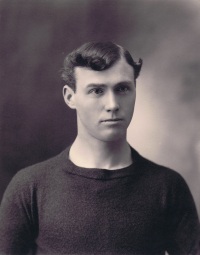
On October 22, 1909, the Vancouver News-Advertiser published its suggestions for an all-star team for the recently-completed 1909 season:
GOAL: Dave Gibbons (Vancouver)
POINT: none named
COVERPOINT: Lionel ‘Toots’ Clarkson (Vancouver)
FIRST DEFENSE: Jimmy Gifford (New Westminster)
SECOND DEFENSE: George Rennie (New Westminster)
THIRD DEFENSE: George Matheson (Vancouver)
CENTRE: Tom Rennie (New Westminster)
THIRD HOME: Bill Turnbull (New Westminster)
SECOND HOME: Cliff ‘Doughy’ Spring (New Westminster)
FIRST HOME: Ernie Murray (Vancouver)
OUTSIDE HOME: Len Turnbull (New Westminster)
INSIDE HOME: Édouard ‘Newsy’ Lalonde (Vancouver)
SPARE (DEFENSE): Waldo Matheson (Vancouver)
SPARE (OFFENSE): Gordon ‘Grumpy’ Spring (New Westminster)
No point player was named – most likely an oversight omission. Charlie Galbraith (New Westminster) or Johnny Howard (Vancouver) would have been the logical choices that season for that particular position.
By and large, a sound list of names with 10 future hall-of-famers although one must still nevertheless question how much homer favouritism was put into the selections by the News-Advertiser when seeing names such as Clarkson and Gibbons making the grade.
‘Toots’ Clarkson only played in 4 matches in his named position that season (Tommy Gifford of New Westminster would have been the wiser choice here) while Gibbons was peppered with more goals than his Salmonbellies opposite ‘Sandy’ Gray and only won 3 of Vancouver’s 10 games.
That said, with no visual references such as film, the news reporters of the day are certainly the closest source to the action for the modern fan. Statistics do not always paint an accurate picture, certainly in regards to defensive players, so perhaps the reporter or reporters who made up the list saw superior aspects of Clarkson’s and Gibbons’ play that has now since been lost to us, the modern reader, from our distant vantage point over a hundred years later.
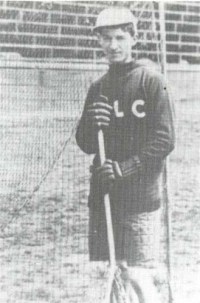
This is especially true with Dave Gibbons. The Vancouver goalkeeper seems to have been regarded highly enough that he eventually saw himself inducted into the Canadian Lacrosse Hall of Fame as a charter member in 1965 – however his playing numbers during the professional era just do not seem to back up that acclaim and greatness compared to other contemporary goalkeepers of his day. How he managed to beat out ‘Sandy’ Gray in the News-Advertiser’s list that season is anyone’s guess. Gibbons could very well have been similar to Cory Hess: his best years occurred before the professional game took off – so a sentimental choice. Or perhaps a case of a great goalie in front of a not-so-great team?
1937 ‘NEWSY’ LALONDE TEAM & 1964 INTERVIEW
An interesting all-star team was published by the Calgary Herald in their September 11, 1937 edition. It was chosen by none other than the legend himself, Édouard ‘Newsy’ Lalonde, listing off his all-time greats: (Players who played lacrosse on the Coast have been marked with an *asterisk)
GOAL: Cory Hess*
POINT: Joe Cattaranich
COVERPOINT: Jim Kavanaugh
FIRST DEFENSE: Mickey Ion*
SECOND DEFENSE: Harry Pickering*
THIRD DEFENSE: Cliff “Doughy” Spring*
CENTRE: Gene “Daredevil” Gauthier
FIRST HOME : Henry Scott
SECOND HOME: Billy Fitzgerald*
THIRD HOME: Albert Dade
OUTSIDE HOME: Henry Hoobin
INSIDE HOME: Gordon “Grumpy” Spring*
Leaning heavy towards Ontario players, ‘Newsy’ Lalonde’s all-star team nevertheless gives great insight as Newsy played both in the West and the East and he himself could be openly critical of teammates who didn’t pull their weight. In other words: there are no slouches here. Looking at these names, this is definitely a pre-Great War team as well as a pre-Coast pro team, as many of these players were plying their trade in the decade prior to professionalism on the Pacific Coast.
As a footnote to this list, pointman Joe Cattaranich would be one of the pioneers who proposed moving the game indoors in 1930 and devised box lacrosse.
During a July 4, 1964 interview with The Montreal Star newspaper, ‘Newsy’ Lalonde listed off Fred ‘Cyclone’ Taylor and Tom Phillips as “fine lacrosse players” and Archie Macnaughton, William ‘Spike’ Hennessy, Weldy Clark, ‘Grumpy’ Spring, Alex Turnbull, Len Turnbull, the Gifford Brothers Tommy and Jimmy, and Fred ‘Mickey’ Ion as other players he rated being “at the top” of the game.
His 1964 list includes some rather interesting and intriguing names: Archie Macnaughton played with Montréal Amateur Athletic Association before coming west in the 1890s and had retired as a player long before ‘Newsy’ started playing senior ball. In fact, Lalonde would have been too young to have ever seen Macnaughton play and so must have based his choice of Macnaughton on what he had heard growing up or talking with those who had knowledge of Archie Macnaughton, as he was justifiably regarded as one of lacrosse’s earliest star players. This perhaps proves Lalonde’s own historical knowledge of the sport.
In reading Weldy Clark’s name, one has to wonder if Lalonde’s memory was fading a notch, mistaking Weldy Clark a half-century later for the great ‘Bun’ Clark – as Weldy’s playing career was short and unremarkable. By including Jim Gifford’s name, Lalonde shows – perhaps grudgingly – his respect towards a fine lacrosse player in an otherwise heated and nasty personal rivalry between the two men that in Gifford’s case still hadn’t passed at the time of the interview. ‘Mickey’ Ion was a tough lacrosse player in his day but ‘Newsy’ was probably much more familiar with Ion from his time as a referee in the National Hockey League.
JOE LALLY’S ‘FIFTY YEARS OF THE BEST’ IN 1944
The famous referee, Mann Cup trustee, Canadian Lacrosse Association founder, and stick manufacturer from Cornwall, Joseph ‘Joe’ Lally, named his all-time Canadian team in a 1944 list he called ‘Fifty years of the best’. Of the twelve players selected by Lally, five of them were Westerners or had played in the West as imports:
‘Bun’ Clark (Toronto Tecumsehs)
Tommy Gifford (New Westminster)
Gordon ‘Grumpy’ Spring (New Westminster)
Édouard ‘Newsy’ Lalonde (Montréal Nationals & Vancouver Lacrosse Club)
Billy Fitzgerald (St. Catharines Athletics)
The remaining players picked were Albert Lewis, Jim Kavanaugh, Hugh Carson, Roddy Finlayson, Charlie Querrie, John Powers, and Henry Hoobin.
1949 TURNBULL-GIFFORD ALL-STARS
In his November 2, 1949 British Columbian newspaper column entitled “The Old-Timer Says…”, sports-writer Vic E Andrew talked about a discussion he had with former greats Len Turnbull and Hugh Gifford regarding all-stars teams for New Westminster and Vancouver. Observing that baseball had Cooperstown and ice hockey would soon have its own hall-of-fame based in Kingston, Ontario (today known as the International Hockey Hall of Fame), Andrew put forth the question “What about lacrosse?”. In response, these were the teams they came up with: (Players associated primarily with the years prior to the professional era are marked with an *asterisk)
NEW WESTMINSTER ALL-STARS
GOAL: Alban ‘Bun’ Clark
POINT: Johnny Howard
COVERPOINT: Tom Gifford
FIRST DEFENCE: Dave ‘Buck’ Marshall
SECOND DEFENCE: Hugh Gifford
THIRD DEFENCE: Harold ‘Haddie’ Stoddart
CENTREMAN: James ‘Pat’ Feeney
FIRST HOME: Alex ‘Dad’ Turnbull
SECOND HOME: Jack Bryson*
THIRD HOME: Bill Turnbull
OUTSIDE HOME: Len Turnbull
INSIDE HOME: Cliff ‘Doughy’ Spring
ALTERNATES: Barlow Galbraith*, Stan Peele*, Jim Gifford, Gordon ‘Grumpy’ Sprung, and Bob Cheyne*
VANCOUVER ALL-STARS
GOAL: Dave Gibbons
POINT: Harry Griffiths
COVERPOINT: Harry Pickering
FIRST DEFENCE: Harry ‘Fat’ Painter
SECOND DEFENCE: George Matheson
THIRD DEFENCE: Everett McLaren
CENTREMAN: Bob Cameron
FIRST HOME: Angus ‘Angie’ MacDonald
SECOND HOME: Ralph Ravey*
THIRD HOME: Nick Carter
OUTSIDE HOME: John ‘Dot’ Crookall
INSIDE HOME: Édouard ‘Newsy’ Lalonde
ALTERNATES: Billy West and ‘Dot’ Phelan
The two teams are quite interesting as they do originate from first-hand sources – two players, Len Turnball and Hugh Gifford, who actually played with and played against – or were very familiar with – all of their careers. It seems the three decades of time which passed may have affected some of the selections. For example, home midfielder Cliff Spring somehow took his brother Gordon’s spot at inside home, while on the Vancouver team the complete absence of Angus ‘Bones’ Allen on the midfield and the inclusion of coverpoint defenceman Bob Cameron, who played just one season on the Coast, as the centreman seems just downright strange.
1950 CANADIAN PRESS GREATEST PLAYER VOTE
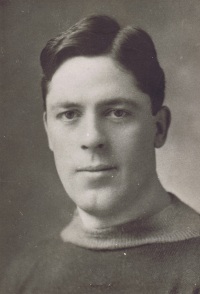
In 1950, a group of Canadian Press journalists voted on the greatest lacrosse player of the first half of the 20th Century.
The list they came up with is less an all-star team and more like a potential wishlist for a future hall-of-fame. In fact, the American authors Alexander Weyand and Milton Roberts outright refer to these selections as being voted for “a Lacrosse Hall of Fame” in their 1965 book “The Lacrosse Story”, the first complete history researched and written about the sport.
Three players with Pacific Coast playing experience received votes: (Players who played lacrosse on the Coast have been marked with an *asterisk)
Édouard ‘Newsy’ Lalonde* – 13 votes
Billy Fitzgerald* – 6 votes
Herry Hoobin – 5 votes
Lionel Conacher – 1 vote
Alex ‘Dad’ Turnbull* – 1 vote
Joe Lally – 1 vote
Lance Isaacs – 1 vote
Didier Pitre – 1 vote
All the players that received votes were born in Eastern Canada – although as we all know, Lalonde did spend almost half his career in Vancouver while ‘Dad’ Turnbull relocated permanently to British Columbia and was so loved and respected by the Coast fans that he can be considered one of our own sons.
Joe Lally’s claim to fame was less as a player and more as a club official and organisational figure – so his lone vote was likely sentimental or political – while Lance Isaacs, who died from a heart-attack during a game in 1937, was notably both the only box lacrosse player and only aboriginal player to receive a vote.
2002 PAUL WHITESIDE ‘ALL-NATIONAL’ TEAM
In Donald M. Fisher’s book Lacrosse: A History of the Game, the author gives five lists of all-time great lacrosse players in the book’s appendix section. In a work heavily devoted to the United States collegiate game, only one of the lists overlaps the same time period of the Pacific Coast pro game, or the “All-National Game Era” of 1880-1920 as it is referred by Ontario lacrosse historian Paul Whiteside.
Unfortunately, the list drawn up by Whiteside for Fisher’s book is centered around Eastern players and only one “Westerner”, ‘Newsy’ Lalonde, makes an appearance on it. This is understandable as at the time of Fisher’s publication (2002), there was scant factual information about the game played on the Pacific Coast. As well, Whiteside’s area of expertise is researching and documenting the Eastern game – a true pioneer in his own right in preserving the early days of the game in that part of the country. Due to geographical distance, he would have had little to no access to western sources for historical data at the time when he compiled his all-star team.
2014 OLD SCHOOL LACROSSE PACIFIC COAST PRO ALL-STAR TEAMS
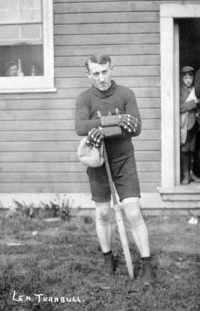
So, for what it is academically worth, Old School Lacrosse has now sat down, looked over the statistics and the history of the era, and come up with two all-star teams to cover the pre- and post-Great War divide in the pro game on the Pacific Coast.
Using the First World War as a division point in the Coast game, to create two all-stars teams, conveniently mirrors the two-year break by organised lacrosse in British Columbia which occurred in 1916-1917. As well, it also conveniently accounts for the changes in team compositions (player reduction from 12 runners to 10 starting in 1919) and the reduction in field-size in 1915.
There were some truly great legends that briefly played as imports on Coast teams (thinking here those brought west by Con Jones and his money) but their peak of greatness happened elsewhere or they had little impact beyond a season or so while playing out west – which is why someone like Billy Fitzgerald (one of the greatest Eastern players) or Cory Hess were left off these teams. Likewise with Salmonbellies legends such as Alex ‘Dad’ Turnbull or Tommy Gifford whose glory days with New Westminster were firmly in the years prior to professionalism.
OLD SCHOOL LACROSSE 1909-1915 PACIFIC COAST PRO ALL-STARS
GOAL: Alban ‘Bun’ Clark (Vancouver/New Westminster)
POINT: Johnny Howard (Vancouver/New Westminster)
COVERPOINT: Dave ‘Buck’ Marshall (New Westminster)
DEFENSE (3): George Rennie (New Westminster); Jimmy Gifford (New Westminster); George Matheson (Vancouver) – honourable mentions: Tom Rennie (New Westminster), Hugh Gifford (New Westminster), and Harry Pickering (Vancouver)
CENTREMAN: Cliff ‘Doughy’ Spring (New Westminster)
MIDFIELD/HOME (3): Angus ‘Bones’ Allen (Vancouver); Bill Turnbull (New Westminster); James ‘Pat’ Feeney (New Westminster)
OUTSIDE HOME: Len Turnbull (New Westminster)
INSIDE HOME: Gordon ‘Grumpy’ Spring (New Westminster) – honourable mention: ‘Newsy’ Lalonde (Vancouver)
OLD SCHOOL LACROSSE 1918-1924 PACIFIC COAST PRO ALL-STARS
GOAL: Bernie Feedham (New Westminster)
POINT: Dave ‘Buck’ Marshall (New Westminster) – honourable mention: Harry ‘Fat’ Painter (Vancouver)
COVERPOINT: Willis Patchell (Mew Westminster)
DEFENSE (2): Hugh Gifford (New Westminster); Laurie Nelson (New Westminster) – honourable mentions: Eustace Gillanders (Vancouver) and Bay Carter (Vancouver)
CENTREMAN: Harold ‘Haddie’ Stoddart (New Westminster) – honourable mention: Everett McLaren (Vancouver)
MIDFIELD/HOME (2); Angus ‘Angie’ McDonald (Vancouver); George Feeney (New Westminster) – honourable mention: Cliff ‘Doughy’ Spring (New Westminster)
OUTSIDE HOME: Jack Gifford (New Westminster)
INSIDE HOME: John ‘Dot’ Crookall (Vancouver)
Looking over and comparing these two teams, what is most interesting is the differences in talent between some positions. For example the defensive line: the 1909-1915 team is chock full of quality, future hall-of-famers to choose from while in the post-Great War era, even with the reduction by one defenseman, this is probably the weakest position for making selections. Apart from Hugh Gifford, an excellent player whose career spanned across both of these teams, the second defensive spot has no clear-cut player to claim it. Nelson, Gillanders, and Bay Carter were all competent players but can be regarded a few notches below in talent compared to everyone else on these two teams; Nelson gets the nod here simply due to bagging a few more goals and having better team success.
In goal, Bernie Feedham was statistically by far the best of the post-war goaltenders – which says something about the other goalies of those years when a transplanted outfield player can step in and excel in that position and in the process lead his team to championships.
Not counting honourable mentions, there are 11 hall-of-famers on the 1909-1915 team but just 6 on the 1918-1924 team – and one of those, ‘Buck’ Marshall, also pulls duty on the 1909-1915 team.
In almost all positions, it is fairly safe to say the 1909-15 players would overshadow their 1918-24 counterparts. Only in the point and coverpoint positions would there be an even battle for supremacy. Both of ‘Buck’ Marshall’s line-mates on these two teams, Howard and Patchell, were players famed for one very important playing ability: knowing how to shut down ‘Newsy’ Lalonde.
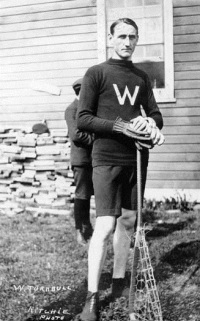
This imbalance does not detract from the personal accomplishments of such greats as Jack Gifford, ‘Dot’ Crookall, or ‘Angie’ McDonald – as all were obviously capable, star players who would have found their marks in the earlier era. But the depth of talent of the post-Great War period does seem to be thinner going through the ranks when in comparison to the pre-war glory years.
Looking back at Newsy Lalonde’s all-star team from 1937, even though his career spanned into the post-Great War era, everyone he chose for it starred before the war. Whether there was an actual weakening of talent post-war is unknown. It could just be a matter of perspective mirroring the weakening of the sport’s attention on the minds of the post-war fans, in that the accomplishments of those who played during the pre-war years are simply inflated from receiving greater fan and press recognition. For the players who followed and made their name after the Great War, with the game dying in the early to mid-1920s there was probably less interest in their heroics as well as less fans to remember their names.
One final note: while ‘Grumpy’ Spring is listed here ahead of ‘Newsy’ Lalonde as the best inside home of 1909-1915, this author believes that ‘Newsy’ Lalonde was, overall and nationwide, the greatest field lacrosse player of the pre-box lacrosse era. ‘Grumpy’ edges out ‘Newsy’ here due to playing his entire career on the Pacific Coast and finishing his career as the greatest pro goal scorer on the Coast. Lalonde’s greatness over Spring on a national scale is buttressed by his solid eastern career first with Cornwall and then later with the Montréal Nationals.